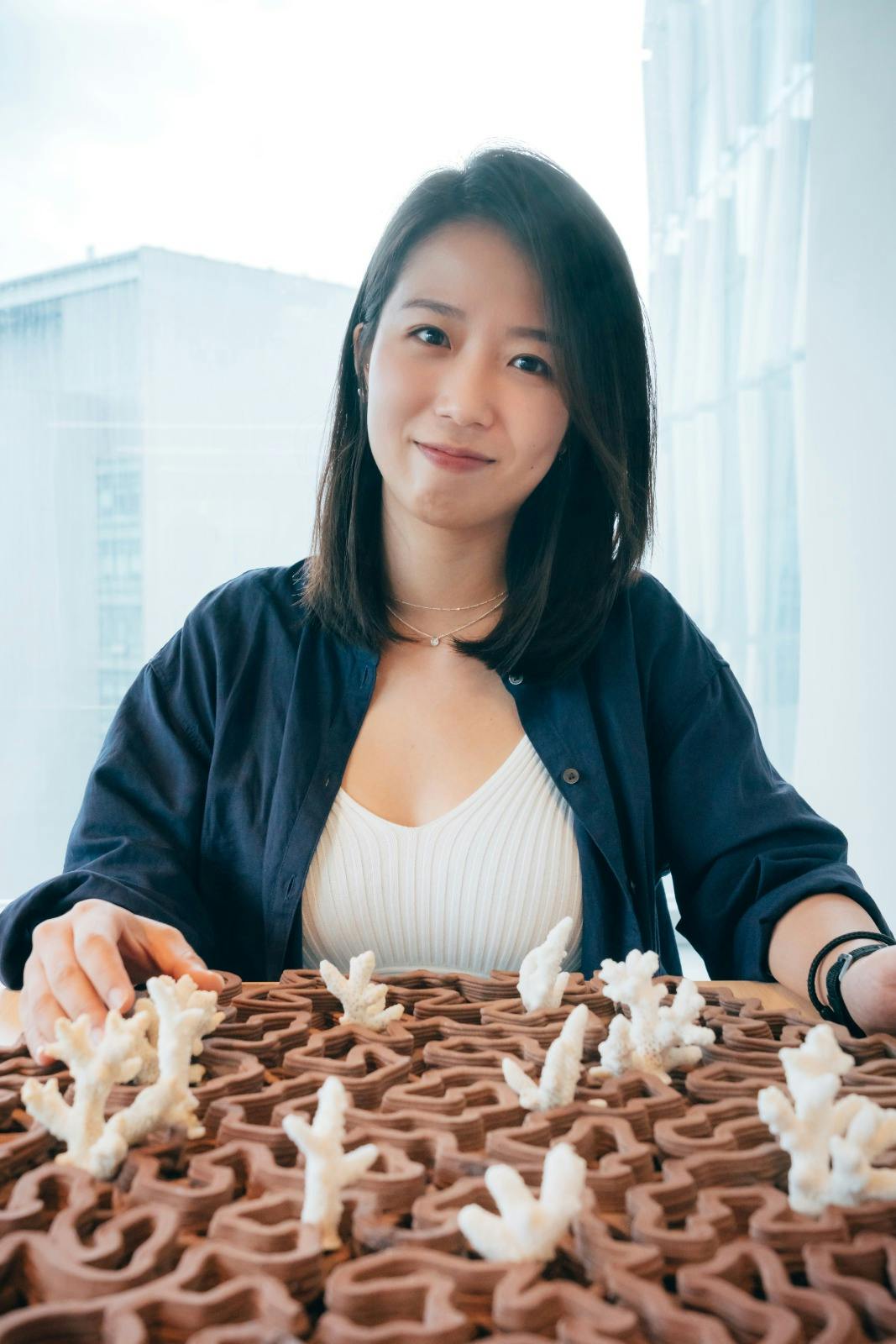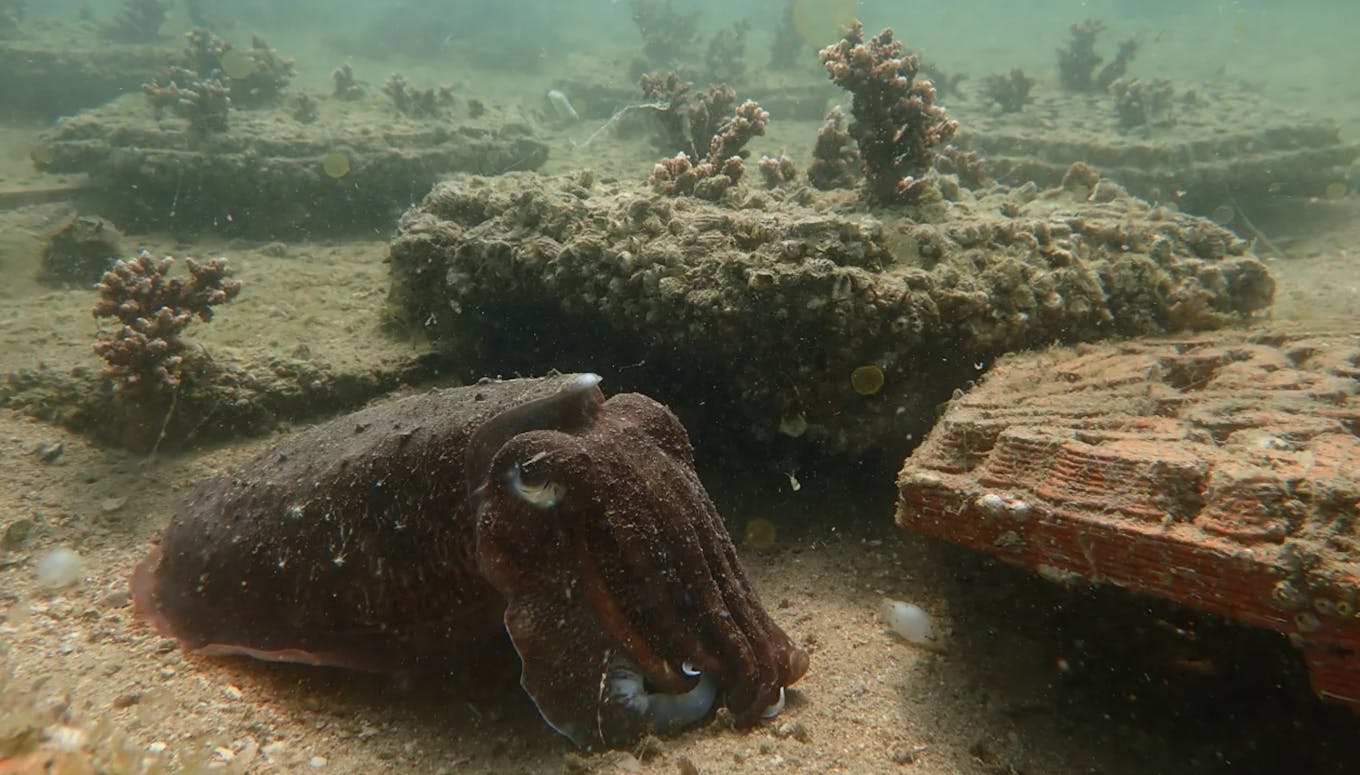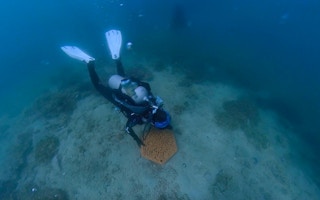Between 2009 and 2018, there has been a progressive loss of about 14 per cent of the coral from the world’s coral reefs, mainly caused by recurring, large-scale bleaching events. The rate of loss has been alarming, and finding a solution to replenish the corals has also been challenging.
To continue reading, subscribe to Eco‑Business.
There's something for everyone. We offer a range of subscription plans.
- Access our stories and receive our Insights Weekly newsletter with the free EB Member plan.
- Unlock unlimited access to our content and archive with EB Circle.
- Publish your content with EB Premium.
Hong Kong’s coral reef systems have not been spared. In 2015, a reef system in Sai Kung’s Hoi Ha Wan Marine Park, among the first batch of marine parks in the urban metropolis, lost 90 percent of its platygyra, a massive stony coral. This was followed by another die-off the following year.
For Vriko Yu, an avid diver, witnessing patches of coral disappearing over a short course of time during her routine dives was devastating. Then a doctoral student working alongside her professor who was trying to find ways to revitalise whole coral reef ecosystems, she experimented with various solutions.
Yu and her professor David Baker, a marine biologist, first came up with the idea of attaching coral fragments to metal grids and concrete blocks, then placing them underwater near other coral to see if they could grow. They soon discovered that the fragments could not survive for long by living on these materials.
Then they would try other methods. What they stumbled upon – terracotta, a natural earthenware clay material used in pottery and art – seemed to be an ideal base for coral fragments to grow and even thrive underwater. Unlike concrete, clay is slightly acidic and has a similar chemical makeup to coral reefs.
For Yu, it was like finding gold.
Yu and Baker would go on to co-found Archireef in 2020, after their bid to 3D-print a terracotta tile yielded results that exceeded their expectations. The two-foot-wide artificial hexagonal tile is a work of biomimicry: its structure mimics the natural formation of the platygyra, promoting the growth of coral fragments and allowing for coral seedlings and marine life to live within the tile’s folds and crevices. Coral fragments attached to the terracotta tiles achieved a survival rate of 98 per cent, said Yu. The tiles, with the growing coral, provided a habitat for sea creatures such as fish, molluscs and other marine organisms to live.
The CEO of the start-up is among 10 winners aged 30 and below recognised by the Eco-Business Youth A-List 2022, which celebrates young sustainability professionals making an impact in Asia Pacific, for her work in trying to use technology to restore coral reef ecosystems.
Yu says that nature requires time for recovery, but with new solutions, more can be done to protect biodiversity.
Since coming up with the artificial tiles, Yu and her team have been planting them around Hong Kong – more than 130 tiles were installed on the seabed in Hoi Ha Wan Marine Park in 2020. The company has also expanded into Abu Dhabi to scale its global footprint, with the team working to replicate the same success in the United Arab Emirates.
Yu speaks to Eco-Business about the challenges that come with entrepreneurship, and how 3D printing – combined with biomimicry – could champion efforts to mitigate the effects of climate change on the planet’s coral reef systems.

Yu posing with the company’s 3D printed terracotta tile. The company has since shifted its production to Abu Dhabi and has plans to continue expanding in the United Arab Emirates. Photo: Vriko Yu
You co-founded Archireef in September 2020. What are some of the challenges that the company has overcome?
It has been quite an exciting two and a half years. One main challenge we faced at the beginning was commercialising a research product. 3D printing terracotta clay tiles is new, so we sought ways to make [the tiles] commercially viable and increase their efficiency and output. We started printing the tiles in Hong Kong but we needed to find ways to save on costs. We decided to shift our production to Abu Dhabi to save on location and operation costs and to also find talent.
The next challenge was securing funding. It was important to engage the private sector and prove to the business community how our product can help the environment, and how our business model would make sense.
Luckily, we have also received funding from organisations such as Hong Kong Science Park, which supports technology start-ups in Hong Kong. We are still in the process of fundraising and have been actively engaging venture capitalists in Singapore and in the UAE.
Can you tell us how the tiles have helped marine life and coral ecosystems so far?
Archireef has deployed over 300 square metres of coral reef tiles in Hong Kong and Abu Dhabi over the past two and a half years, which is around 600 to 800 tiles.
We have been studying the associated biodiversity around coral and have seen a significant increase in coral, fish and invertebrates such as crabs, shrimp and sea cucumbers. This is helping us to prove that our tiles can enhance the abundance and biodiversity of reef fish. We have also been using environmental DNA to fully quantify and capture biodiversity that we cannot see with the naked eye, which is all very exciting.
However, it takes time for nature to recover, and change won’t happen overnight. As part of our business model, we conduct regular monitoring and report our findings to our clients over a minimum period of three years. This allows them to monitor the ecological impact with us and is part of our three-step model, which includes defining the restoration site and scope of the project, deploying the reef tiles and then monitoring how the tiles are performing.

A female cuttlefish seeking refuge near one of Archireef’s 3D printed terracotta tiles. Image: Vriko Yu
What is most rewarding or satisfying about playing a part in the restoration of coral reef ecosystems?
I’m a scientist by training, so naturally, I get very excited every time we visit the tiles. We have been following a mother cuttlefish that’s been “hanging out” at one of our deployment sites in Sai Kung, Hong Kong. We have already seen her more than three times. She likes to hide under our tiles and use them to wait for prey, and we even saw her laying eggs on our tiles once. Whenever we go into the water and see that there’s been a significant increase in life in places once lifeless, these are the moments that really count.
How else do you envision 3D printing to have an impact in terms of sustainability?
3D printing is extremely versatile, allowing us to easily change or modify a design of a product, or add another level of structural intricacy and complexity. This is something that moulding might not be able to deliver. So in terms of sustainability, 3D printing helps us to design our tiles to adapt to the environment of the surrounding coral better; we can use composite materials like clay to embed products within nature with little or no interruption or disruption. 3D printing also helps to keep production costs low, especially when a design’s model needs to be changed or updated.
“
Whenever we go into the water and see that there’s been a significant increase in life in places once lifeless, these are the moments that really count.
Vriko Yu
Archireef launched its newest facility in Abu Dhabi in December 2022. What are the company’s plans for expansion within Hong Kong and Abu Dhabi? What has been most striking about working between the two cities?
Hong Kong has provided us with very good early-stage support, while Abu Dhabi is like a launch pad; it is allowing us to scale at a faster pace. There is also more of an appetite for sustainable innovation now in the private sector within the region, especially with COP28 taking place this year in the UAE. So right now we are keeping our heads down and focusing our business in Abu Dhabi and the UAE.
I have been visiting Abu Dhabi on and off since early 2022, but I’ve recently chosen to relocate here and have been here since February 2023 to focus on the company’s expansion.
It’s taken some time getting used to being here, but I appreciate the work-life balance. This is actually my first time living outside of Hong Kong, which is a very fast-paced city, and known for its long working hours.
What is the hardest aspect of your job and what advice do you have for entrepreneurs who are getting into the sustainability space?
I didn’t have much working experience before founding this company. So for me, it’s been a case of knowing how to assemble a team that complements each other and fully understands [the company’s] mission, and has the passion to keep pushing despite the ups and downs.
I advise other sustainability entrepreneurs to put themselves in the shoes of businesses and really understand how their solutions can benefit them. This will make a huge difference in selling your solution.
What sparked your interest in sustainability in the first place?
I was born and raised in Hong Kong, which isn’t really regarded by most as a place with a lot of nature. Most think it’s only a modern metropolis full of skyscrapers, but there really is a lot of nature within reach, especially in areas like the New Territories, which is where I grew up.
Being surrounded by the mountains and sea helped me to develop a curiosity and affinity for nature, which, combined with my passion for diving, continues to drive me to preserve it for future generations.
Read our stories with other A-List winners here.





















